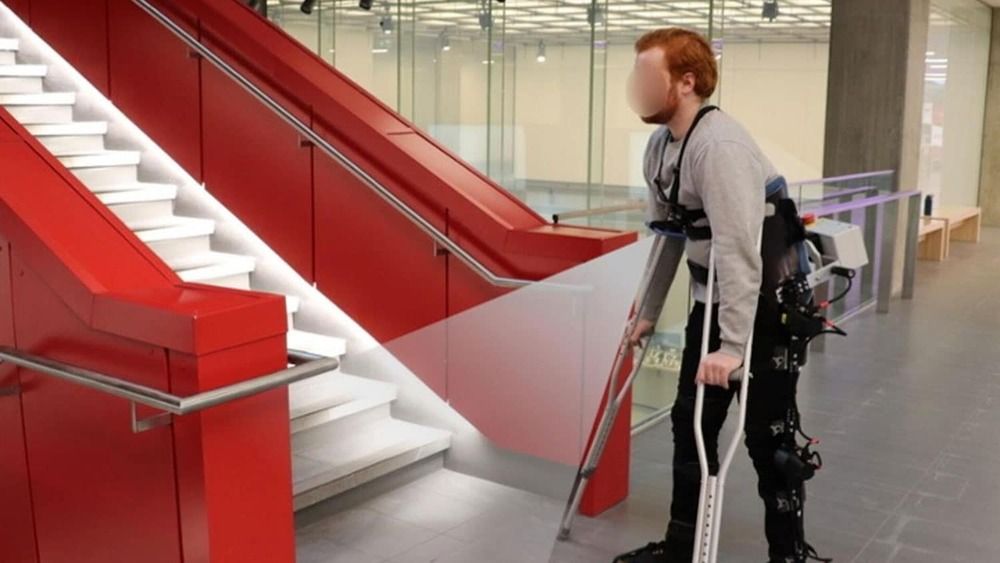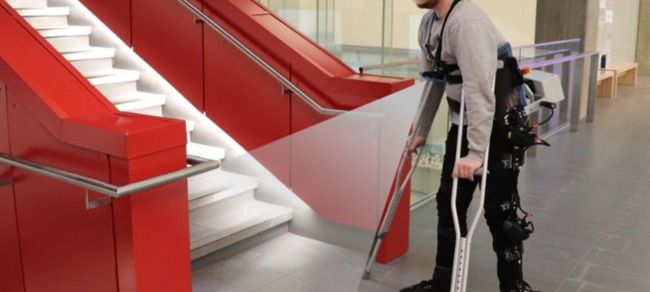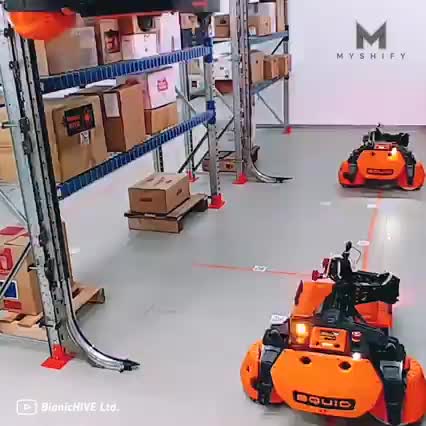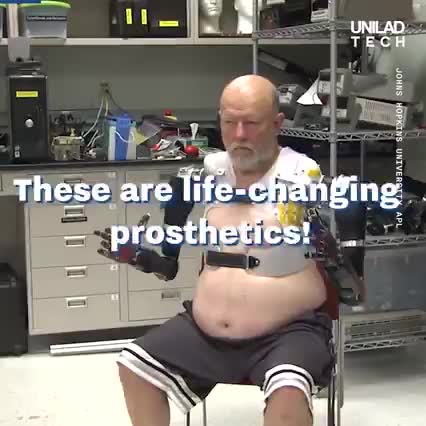# **A Portable, Self-Contained Neuroprosthetic Hand with Deep Learning-Based Finger Control**
Nguyen et al.: https://arxiv.org/abs/2103.
#Robotics #ArtificialIntelligence #HumanComputerInteraction

# **A Portable, Self-Contained Neuroprosthetic Hand with Deep Learning-Based Finger Control**
Nguyen et al.: https://arxiv.org/abs/2103.
#Robotics #ArtificialIntelligence #HumanComputerInteraction
You are constantly adjusting your walking parameters based on the feedback you’re getting from your environment. You walk differently on a soft surface, you prepare yourself before using stairs. Meanwhile robots cannot really do that, especially exoskeletons. These robotic legs could help disabled people walk again on their own, but how could they prepare to stop, climb stairs, make a sharp turn? Scientists believe that in the future exoskeletons are going to be smart thanks to cameras and artificial intelligence.
Currently exoskeletons need to be controlled manually via smartphone applications or joysticks. This is less than ideal, because the disabled person can’t walk as intuitively as an able-bodied person can. And his or her hands are always occupied with these controls. That kind of a cognitive load is extremely tiring and can be dangerous over time. Could you imagine needing to take out your phone every time you want to climb a set of stairs or walk through a strip of sand? Scientists want to borrow a page from a book about autonomous cars and therefore are optimizing AI computer software to process the video feed to accurately recognize stairs, doors and other features of the surrounding environment.
Brokoslaw Laschowski, leader of the ExoNet research project, said: “Our control approach wouldn’t necessarily require human thought. Similar to autonomous cars that drive themselves, we’re designing autonomous exoskeletons that walk for themselves.”

The robotic exoskeletons can think and make control decisions on their own.
Robotics researchers are developing exoskeleton legs capable of thinking and making control decisions on their own using onboard cameras and sophisticated artificial intelligence technology.
As the name suggests, an exoskeleton leg is an external structure that can be used to support people who are otherwise unable to walk. But the things still do have limitations; most existing exoskeleton legs must be manually switched over to different modes – via smartphone applications or joysticks – for more complicated tasks, such as stepping over or around obstacles.
“That can be inconvenient and cognitively demanding,” said Brokoslaw Laschowski, a Ph.D. candidate in systems design engineering who leads a University of Waterloo research project called ExoNet. “Every time you want to perform a new locomotor activity, you have to stop, take out your smartphone and select the desired mode.”
Devices shift away from Robocop-like wearables to simpler, more accessible assistive solutions.
There are many, many wearable and portable devices aimed at improving life for the blind and visually impaired (in some cases, even restoring vision). Such devices have been developed for pretty much every part of the body: fingers, wrists, abdomen, chest, face, ears, feet, even the tongue.
The thing is—people don’t want to wear them.
“All of these wearables currently on the market have very low acceptance from the community because you look like some sort of RoboCop when you wear them, and people don’t want to attract attention to their impairment,” said Ruxandra Tivadar of the University of Bern in Switzerland, during the annual meeting of the Cognitive Neuroscience Society (CNS), held virtually this week.
All of which would be nice and handy, but clearly, privacy and ethics are going to be a big issue for people — particularly when a company like Facebook is behind it. Few people in the past would ever have lived a life so thoroughly examined, catalogued and analyzed by a third party. The opportunities for tailored advertising will be total, and so will the opportunities for bad-faith actors to abuse this treasure trove of minute detail about your life.
But this tech is coming down the barrel. It’s still a few years off, according to the FRL team. But as far as it is concerned, the technology and the experience are proven. They work, they’ll be awesome, and now it’s a matter of working out how to build them into a foolproof product for the mass market. So, why is FRL telling us about it now? Well, this could be the greatest leap in human-machine interaction since the touchscreen, and frankly Facebook doesn’t want to be seen to be making decisions about this kind of thing behind closed doors.
“I want to address why we’re sharing this research,” said Sean Keller, FRL Director of Research. “Today, we want to open up an important discussion with the public about how to build these technologies responsibly. The reality is that we can’t anticipate or solve all the ethical issues associated with this technology on our own. What we can do is recognize when the technology has advanced beyond what people know is possible and make sure that the information is shared openly. We want to be transparent about what we’re working on, so people can tell us their concerns about this technology.””
When augmented reality hits the market at full strength, putting digital overlays over the physical world through transparent glasses, it will intertwine itself deeper into the fabric of your life than any technology that’s come before it. AR devices will see the world through your eyes, constantly connected, always trying to figure out what you’re up to and looking for ways to make themselves useful.
Facebook is already leaps and bounds ahead of the VR game with its groundbreaking Oculus Quest 2 wireless headsets, and it’s got serious ambitions in the augmented reality space too. In an online “Road to AR glasses” roundtable for global media, the Facebook Reality Labs (FRL) team laid out some of the eye-popping next-gen AR technology it’s got up and running on the test bench. It also called on the public to get involved in the discussion around privacy and ethics, with these devices just a few scant years away from changing our world as completely as the smartphone did.

Robotics researchers are developing exoskeleton legs capable of thinking and making control decisions on their own using artificial intelligence called ExoNet
THE PROBLEM
Current generation of exoskeleton legs need to be manually controlled by users via smartphones or joysticks, It has a problem where motors need to change their operating mode manually when they perform a new activity in different terrains.


Elon Musk recently provided a quick update on the highly-anticipated Cybertruck’s development, with the Tesla CEO noting that the all-electric pickup’s final design is looking good. Musk shared his thoughts on Twitter after he visited the vehicle at Tesla’s studio.
The Cybertruck is arguably Tesla’s most radical vehicle to date, thanks in part to its unorthodox brutalist design and angular exoskeleton. Starting at less than $40000, the Cybertruck has the potential to break into one of the most lucrative vehicle segments in the United States. But to accomplish this, the Cybertruck must have the necessary balance between all-electric performance and classic pickup characteristics.
Final design is looking👌 Was just in the studio.

